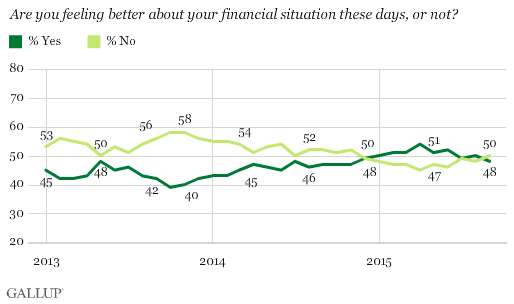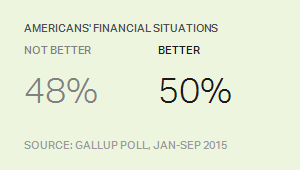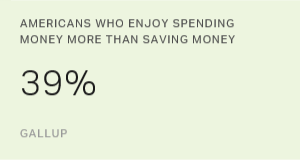Story Highlights
- Americans are somewhat more positive now than in 2013
- Seven in 10 have enough money to buy what they need
- Most Americans say they monitor their spending closely
PRINCETON, N.J. -- Half of Americans, on average, so far this year say they are feeling better about their financial situation. This may not seem like a highly positive state of affairs, but it marks a modest improvement from two years ago, when an average of 43% said they were feeling better about their finances.

This question is one of a set of personal financial measures Gallup has been asking Americans on a daily basis since 2013. As is the case with most questions that focus on Americans' personal situations and behaviors, these measures have been quite stable over time. Thus, the shift from 2013 when 43% said they were feeling better about their finances and 55% said they were not -- a 12-percentage-point gap -- to the 50% positive and 48% negative attitudes today -- a two-point gap -- represents a clear improvement.

On a more granular level, there has been a slight pullback in these positive attitudes over the past three months; the percentage of Americans who say they are feeling better about their finances has edged down slightly compared with the early months of this year.
This question taps into a sense of how Americans' finances may be changing. Two other measures focus on Americans' attitudes about the current state of their finances, and show major differences in the ways Americans view their money.
Seventy-one percent of Americans so far this year say they have "enough money" to buy the things they need, while less than half as many, 31%, say they have "more than enough money" to do the things they want to do. These two questions indicate roughly equal numbers of Americans who are financially distressed, saying they lack the means to get by on a daily basis, and who are financially flush, saying they have more than they need.
Majority Still Claim They Are Cutting Back on Their Spending
Americans clearly like to believe they are monitoring their spending closely, with 60% so far this year reporting they are cutting back on how much money they spend each week. While this remains the clear majority of Americans, it is down modestly from the average 65% in 2013 who said they were cutting back.

While six in 10 Americans are trying to cut back on their spending, an even higher percentage of Americans, 87% so far this year, agree with the statement, "You are watching your spending very closely." The breadth of this sentiment underscores the value Americans place on appearing responsible about their spending, even among those with high incomes and high net worth.
Implications
These questions reflect not just the reality of how much money people have, but also how they think about their financial situation. Even though Americans are slightly more positive than they were two years ago, they are clearly not greatly optimistic about their financial situation, with just about half saying they are feeling better about it. And while Americans like to feel they are monitoring their spending closely and attempting to control how much they spend, these attitudes have not changed dramatically since 2013.
These attitudes help explain the approach taken by many retailers that continually market their products and services as being discounted and "on sale," even if in some situations the sale price is in reality the normal selling price. For many Americans, buying something appearing to be on sale fits with their views of themselves as careful stewards of their money. Several years ago, leaders at retailer J.C. Penney attempted to adopt a "rational" pricing scheme, which eschewed the constant sale pricing that had been in use previously, and quickly learned their mistake. The approach failed, the CEO who instigated it was fired, and J.C. Penney went back to the consistent sale pricing that it had used previously.
The current results also underscore that most Americans' personal financial situations are quite stable, even as Americans' attitudes about what is happening "out there" in the country at large can undergo more significant shifts in short periods of time.
Historical data are available in Gallup Analytics.
Survey Methods
Results for this Gallup poll are based on telephone interviews conducted on the Gallup U.S. Daily survey, with a random sample of approximately 3,500 to 4,000 adults, aged 18 and older, living in all 50 U.S. states and the District of Columbia, asked to answer each financial question each month. For results based on the total monthly sample of national adults, the margin of sampling error is ±2 percentage points at the 95% confidence level. All reported margins of sampling error include computed design effects for weighting.
Each sample of national adults prior to September 2015 includes a minimum quota of 50% cellphone respondents and 50% landline respondents, with additional minimum quotas by time zone within region. For the month of September 2015, the sample includes a minimum quota of 60% cellphone respondents and 40% landline respondents. Landline and cellular telephone numbers are selected using random-digit-dial methods.
Learn more about how the Gallup U.S. Daily works.
